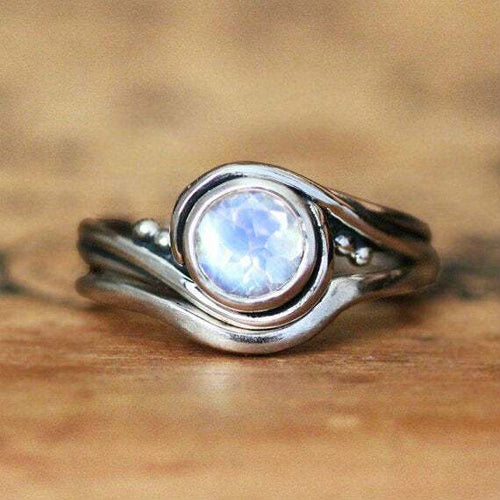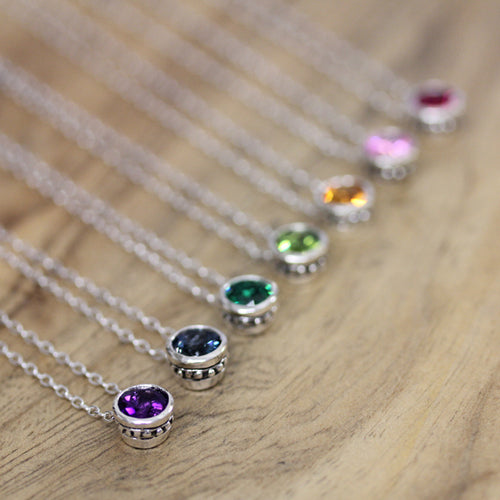We’re in the final stretch! The next step to making my new earrings come alive is soldering the posts to the bezels, adding a patina, setting the stones and then polishing them. Soldering is a fine art in of itself. You want to get the metal hot enough that the solder will flow, but not hot enough that it will melt the metal. It's a fine line! I love hearing the sound of the hot metal hissing as I put it into fresh water to quench it once it's been soldered, that little sizzling hiss makes me happy (it's the little things!). Things to consider when I'm soldering is what temperature I need to melt the solder to connect the post to the bezel. This is the science of metal melting points and you come to learn how the metal changes color as it gets near it's melting point (for show, the bezel on the right is a cherry red and would turn yellow and get glassy right before it melts). It's something you come to learn as you work more and more with soldering and it's one of my favorite parts of jewelry making! 
 One of the things that makes my work unique is that I like to add a patina to my pieces. For me I like the contrast of the black in the recesses next to the bright shine of the polished silver. It gives an antique feel and makes the details pop more (and you know I love the details). It’s my personal preference, but if you don’t like that finish, you can always ask me to leave off the patina. I think it really makes the decorative elements that I add to my pieces stand out. Especially the Brontë earrings as they have a lovely filigree to them. When I set the stones I use a vice that attaches to my bench. This holds the piece that I’m setting (whether it’s a ring, earring or pendant) straight and it doesn’t move, this is important when setting stones! It also lets me use both my hands which has made such a big difference in how I make my work. So the next step is when I cut the "seat" so that the stone will fit securely into the bezel. I use a special drill bit that is tapered to mimic the shape of the stone and slowly carve the inside of the bezel. This makes a little shelf inside that will cradle the gem securely when I push the metal over the edges. Every stone is different and unique, so each seat needs to be cut individually to make sure the stone fits perfectly. In this case it took a few passes for me to make sure the stone fit, we're getting close now!
One of the things that makes my work unique is that I like to add a patina to my pieces. For me I like the contrast of the black in the recesses next to the bright shine of the polished silver. It gives an antique feel and makes the details pop more (and you know I love the details). It’s my personal preference, but if you don’t like that finish, you can always ask me to leave off the patina. I think it really makes the decorative elements that I add to my pieces stand out. Especially the Brontë earrings as they have a lovely filigree to them. When I set the stones I use a vice that attaches to my bench. This holds the piece that I’m setting (whether it’s a ring, earring or pendant) straight and it doesn’t move, this is important when setting stones! It also lets me use both my hands which has made such a big difference in how I make my work. So the next step is when I cut the "seat" so that the stone will fit securely into the bezel. I use a special drill bit that is tapered to mimic the shape of the stone and slowly carve the inside of the bezel. This makes a little shelf inside that will cradle the gem securely when I push the metal over the edges. Every stone is different and unique, so each seat needs to be cut individually to make sure the stone fits perfectly. In this case it took a few passes for me to make sure the stone fit, we're getting close now! 


Next I use my flexshaft with a hammer handpiece in it which pushes the silver (or other metal) over the stone to keep it in place. It can be tricky, because you need to make sure that while you’re setting one side of the stone, it is flat and not popping out on the other side. It takes a lot of practice – thankfully I’ve set thousands of stones in my life, so you’re in good hands (pardon the pun).
 Once the stone is set it’s off to the polishing wheel. This can get messy and it’s important to wear protection (apron, goggles, leather finger protectors). My polishing wheel is enclosed, so it’s a little less messy, but all of the protection above is good to wear in a studio anyway. I start by using a Tripoli polishing wheel to buff off any large scratches that may have occurred while setting the stones, I then use a blue rouge for a final polish, this really makes the piece sparkle brightly!
Once the stone is set it’s off to the polishing wheel. This can get messy and it’s important to wear protection (apron, goggles, leather finger protectors). My polishing wheel is enclosed, so it’s a little less messy, but all of the protection above is good to wear in a studio anyway. I start by using a Tripoli polishing wheel to buff off any large scratches that may have occurred while setting the stones, I then use a blue rouge for a final polish, this really makes the piece sparkle brightly!
 You may think that that’s the end of it, the earrings are done, what else needs to happen? Well, now comes photographing the pieces so that I can add them to Etsy and my website so that you can buy them! I also need to organize social media posts (Facebook and Instagram) and photos, write the description for the piece, price it and then advertise it! There is a lot that goes into making a collection come alive!
You may think that that’s the end of it, the earrings are done, what else needs to happen? Well, now comes photographing the pieces so that I can add them to Etsy and my website so that you can buy them! I also need to organize social media posts (Facebook and Instagram) and photos, write the description for the piece, price it and then advertise it! There is a lot that goes into making a collection come alive!
More inspiration from the collection: “I love the ground under his feet, and the air over his head, and everything he touches and every word he says. I love all his looks, and all his actions and him entirely and all together.” E Brontë, Wuthering
Behind the Scenes


